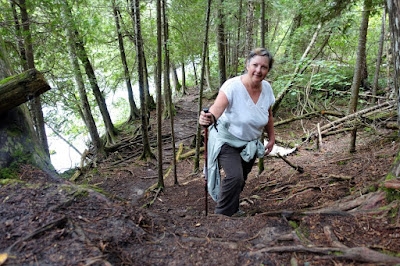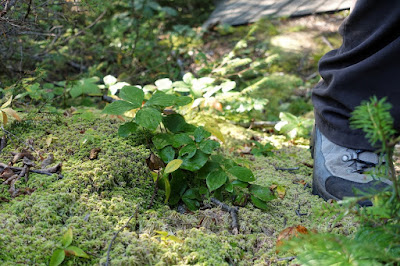Entry 4 – Friday 18th to Thursday 31st August 2017
The weather
forecast for the next week was rain and more rain. So much for the catch phrase
“come and experience Canada’s beautiful summer.” We did have a limited time
frame and a wish list to experience. There was only one thing to do and that
was to push on.
We drove in
the rain arriving at our next destination, “Fairbanks Provincial Park,” located
on Fairbank Lake. This park was set up primarily for family enjoyment and it
was full of kids. We were lucky to be allocated a private beach front camp site
which was special in its own right but was only available for a single night.
We decided to hire a canoe for a 24-hour period parking it on our own bit of
private beach. The weather forecast was for continuing rain and we decided not
to erect our tent for the night. We parked our van in a position where we could
erect our tarp over the rear of the van, securing it to some nearby trees and
we positioned the site’s camp bench under the tarp. And yes it was another different
camping experience for us.
The rain
eased and we dressed appropriately for a cruise in our canoe. We followed the
coast line viewing other camp sites, some with various types of floatation
devices including motorised boats secured out front of their private section of
beach. Further around the lake we paddled past private residents ranging from
shanty shacks to some very expensive looking homes. The wind started to blow
making it difficult to paddle and the calm lake surface became choppy with
about a kilometre of water between us and our camp site on the other side of
the lake. Mary was feeling a bit anxious (memory flashes of an overturning
canoe) with Steve, as the only paddler, gritting his teeth and utilising all
his strength to keep the canoe moving and steady.
Camp sites
in Canada’s Provincial Parks are yours until 2 pm with the entry fee component
current till 10 pm on the day. If over the day you decided to view other
Provincial Parks along your route that same entry fee also covers you for
admission at other parks. We enjoyed this system where there was no pressure to
pack and vacate your site early in the day. When we did depart it was with a
relaxed state of mind making for safer driving conditions, enhancing your state
of mind and well-being created by the beauty of nature.
About 1 ½
hours later we arrived at Chutes Provincial Park with dry conditions where we
camped in our tent for two nights. Chutes was different again. Still a great
bush setting but with a river flowing by, a great walking track with a couple
of bridges over the flowing river waters, some lookouts to view some impressive
rapids and a swim beach nearby. We walked around the nearby town of Massey
viewing an interesting museum and naturally stopped for a nice cool down,
downing an ice cream each.
We were
enjoying the unpressured departure time, allowing the morning dew to dry from
the tent before packing it away. We then sat at the falls having a bite to eat
before driving to the town of Sault Ste Marie located on the U.S.A. border
where we stayed in accommodation for the night and restocked our pantry. The below picture shows the bridge
link to USA.
We were
still experiencing some communication issues and sort further assistance from a
phone store before departing Sault Ste Marie. As it turned out our unlocked
Telstra phone didn’t have all the required background programs to operate on
the Canadian system and our Canadian phone was unable to link to our laptop
which we had purchased specifically for our Canada holiday to assist with
research during our travels.
We had been
advised Canada had two primary seasons. The winter season and the construction
season, due to most things coming to a halt in winter. When the weather fines
up it is full steam ahead for the construction industry which included for us
many delays driving due to road works.
Leaving
Sault Ste Marie, with a drive of about 130 kilometres to our next destination
revealed the volume of road works we could incur in a different manner. We had
missed breakfast that morning and decided to consume one slice of freshly
purchased fruit loaf at each stop for road works. By the time we reached our
destination at Lake Superior Provincial Park our loaf was down to the last two
slices and we no longer craved breakfast.
Lake
Superior Provincial Park campground was set on the shores of the world’s
largest fresh water lake, “Lake Superior”, with a surface area of 82,100 square
kilometres holding a 10th of the planets fresh water. The provincial
park was set up like Algonquin Provincial Park which involved a lot of driving
to view the highlights of the park or hike the walking trails located away from
the campground.
On one of our hikes a Canadian couple instigated a conversation with us which continued with a fire chat until 11.30pm that evening. We thoroughly enjoyed the company of Ryan, Cassandra and Jasper. We reiterated to them how impressed we were with the politeness of Canadians. Ryan agreed but pointed out that Canadians didn’t socialize like Australians. It seems we Australians take our “happy hours,” for granted.
Our next
destination was our first experience in a Canadian National Park. Pukaskwa
National Park was another wonderful experience, with glorious coastal views
along the shoreline of Lake Superior. All the hiking trails started from the
campground including a canoe launching beach. Pukaskwa National Park had about
2 kilometres of access roads with the rest of the parks, 135 kilometres of
coastline and inner land mass left
untouched natural wilderness. National Parks are different to Provincial Parks which
are working parks, incorporating tourism, logging and commercial activities.
We participated in an Indian drum / song session (Anishinaabe camp of Ojibway tribe) which created a sense of serenity. Mary got to use the shaker rattle for one song and Steve was tasked with keeping the rhythm up with the drum.
The night time temperatures were hovering around 4 C where we were needing to go to bed with socks and clothing on to keep warm. As it turned out this was a cold location with arctic mosses found throughout Pukaskwa National Park about a thousand kilometres south than normally located.
Our next
destination was Neys Provincial Park where we were allocated a camp spot within
30 metres of the beach still on Lake Superior. Once again this park was a
little different, a long beach with fine sand similar to most Australian
beaches we love so much. Lying in bed at night your body would relax to the
sound of the wave action gently lapping at the shore line. The one thing we
were not tempted to do whilst travelling the coastal regions of Lake Superior
was to go for a dip or swim. The water temperature was a steady 4 – 7 C. One
lady who had been for a dip said the temperature didn’t affect her due to not
able to feel anything as her whole body had become numb.
There were a
few walking trails available and we chose one of the slightly harder ones due
to its potential scenic views. The daily maximum temperature was estimated to
be 17 C with humidity at 88 percent. Disappointingly we didn’t get to complete
this hike as the humidity sapped all our strength. Even Steve who is rarely
affected was struggling with the humidity. We were still gone for nearly 3
hours but were both left feeling exhausted the rest of the day.
Our time on the eastern side of Canada was nearing an end. We still had about a dozen locations on our wish list within the nearby region. We chose to bypass some and travelled 250 kilometres to Sleeping Giants Provisional Park which was by then at the top of our wish list. We arrived at 3.30 pm feeling exhausted having travelled in thick fog all day with visibility down to about 50 metres for at least a quarter of the distance.
There were
still plenty of road works to contend with, some with workers huddled in groups
due to dangerous conditions caused by limited visibility and others hard at
work trying to complete tasks before the arrival of the winter.
About 60
kilometres prior of Sleeping Giants Provincial Park we deviated to view Ouimet
Canyon, a 100 metre deep gorge, 150 metres wide.
Arriving at
Sleeping Giants Provincial Park we were immediately very happy with our gut decision
and disappointed at the same time with only two nights available before we
needed to make a U turn, preferring the opportunity for a few weeks at this
location to soak up its beauty.
We hiked
along some of the walking tracks admiring the scenery and sighted a wild deer
on three occasions and a native fox on another. We were lucky to have good
timing arriving at “Sea Lion” rock, (now missing its head) with the appearance
of a passing canoe detouring under the Sea Lion formation.
Even the
passing canoe looked very well set up with the appearance a bit like a bulk
ship carrier with the hull enclosed between the rowers. People go canoeing for
days, some weeks visiting the back country, camping in amongst the wilderness.
There are many long-distance canoeing trails like long distance hiking trails
where you can spend a night or several nights hiking / canoeing along these
trails.
It was time
to execute a U turn and head back to North Bay. Big kilometres ahead for us over
the next 3 days. A stop along the way for a Tim Hortons hot chocolate and free
internet to upload our blog.





















































thank you for sharing part of your journey with Tammy and I !!!!! Enjoy the rest of your trip.
ReplyDelete